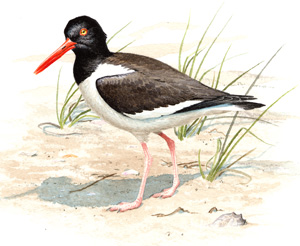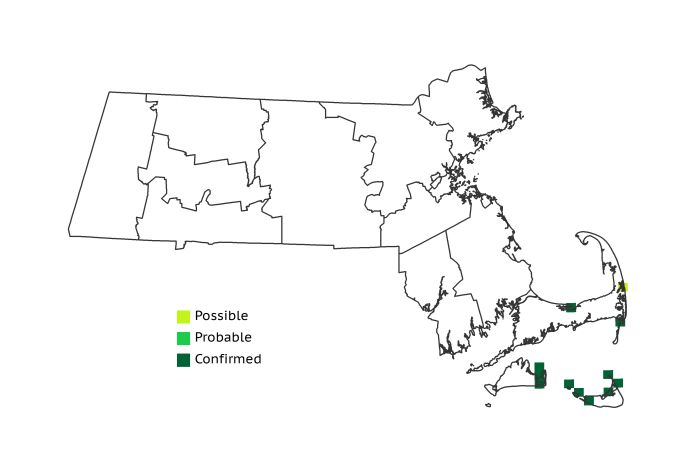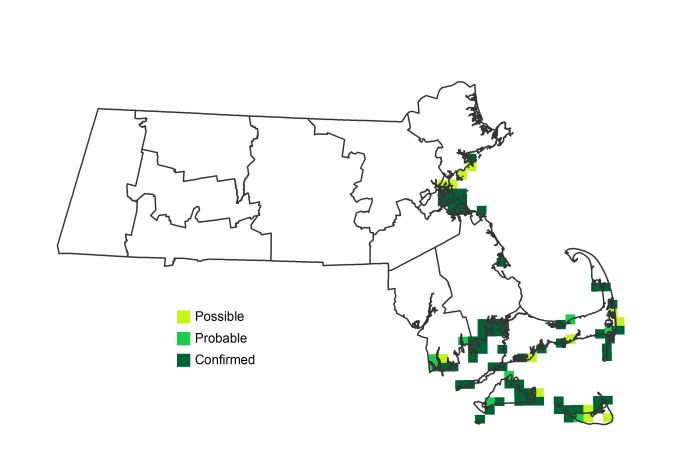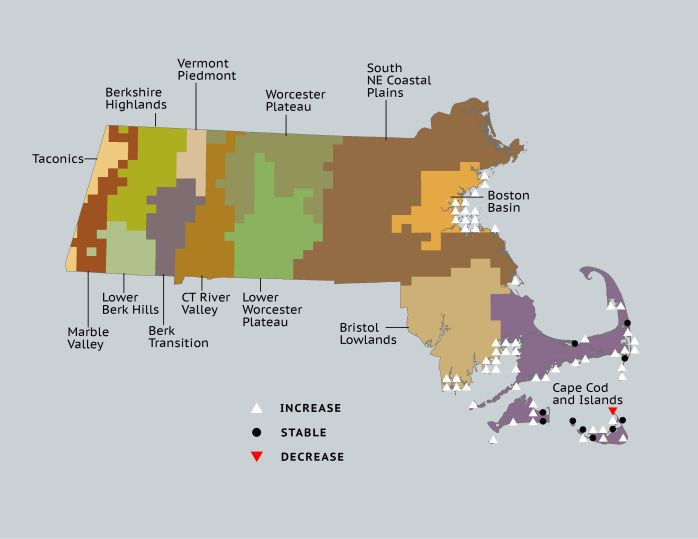Breeding Bird Atlases (BBA)
Find a Bird
American Oystercatcher
Haematopus palliatus

Local and strongly increasing
State Wildlife Action Plan listed
“Why then the world’s mine oyster, / Which I with sword shall open.” – William Shakespeare, The Merry Wives of Windsor
With a few swift strokes of its bill, the American Oystercatcher can pry open a recalcitrant bivalve as easily as with a sword. Its bright red bill, yellow eyes, and bold pattern make it stand out amongst the ranks of beach-dwelling birds, whose styles as a whole tend toward the understated. Sadly, it may have been its conspicuous plumage that drew the attention of market hunters and egg collectors to its populations along the Atlantic coast, where this striking bird was rendered virtually absent as a breeder in Massachusetts for nearly a hundred years.
Historic Status
Although John James Audubon alleged that the American Oystercatcher bred as far north as Labrador in the 1800s (Audubon 1840), there is no historical evidence to verify this assertion. There is no doubt, however, about whether the American Oystercatcher has long been on the Massachusetts coast. Alexander Wilson received a specimen shot in Boston Harbor sometime prior to 1814, and Daniel Webster, the statesman, shot two in Marshfield in 1837 (Howe & Allen 1901). Most observers only knew the species as an accidental southern visitor for the next century and a half, with only 13 appearances in the state between 1900 and 1955 (Griscom & Snyder 1955). The frequency of American Oystercatcher reports gradually increased for the next 15 years, until a pair was found breeding on Martha's Vineyard in 1969 (Petersen & Meservey 2003).
Atlas 1 Distribution
After a rather sordid early history in Massachusetts, the American Oystercatcher seemed ready to give the Bay State another chance by the time of Atlas 1. All breeding records in Atlas 1 came from Cape Cod and the Islands, with only a handful of mainland records situated on the Mid to Outer Cape Cod. The Islands were really the center of breeding oystercatcher distribution, especially Nantucket, Tuckernuck, and Muskeget Islands, which together accounted for half of all occupied blocks. The eastern side of Martha’s Vineyard also hosted breeding American Oystercatchers in the late 1970s.
Atlas 2 Distribution and Change
The American Oystercatcher has made a strong recovery and has become a fairly common breeding bird along our coast, expanding into 59 new blocks since Atlas 1. An American Oystercatcher Working Group used focused research to evaluate the status and trends of oystercatchers breeding on the Atlantic coast and has provided improved understanding of oystercatcher breeding biology and the potential threats to this species’ expanding population.
Atlas 1 Map

Atlas 2 Map

Atlas Change Map

Ecoregion Data
Atlas 1 | Atlas 2 | Change | ||||||
Ecoregion | # Blocks | % Blocks | % of Range | # Blocks | % Blocks | % of Range | Change in # Blocks | Change in % Blocks |
Taconic Mountains | 0 | 0.0 | 0.0 | 0 | 0.0 | 0.0 | 0 | 0.0 |
Marble Valleys/Housatonic Valley | 0 | 0.0 | 0.0 | 0 | 0.0 | 0.0 | 0 | 0.0 |
Berkshire Highlands | 0 | 0.0 | 0.0 | 0 | 0.0 | 0.0 | 0 | 0.0 |
Lower Berkshire Hills | 0 | 0.0 | 0.0 | 0 | 0.0 | 0.0 | 0 | 0.0 |
Vermont Piedmont | 0 | 0.0 | 0.0 | 0 | 0.0 | 0.0 | 0 | 0.0 |
Berkshire Transition | 0 | 0.0 | 0.0 | 0 | 0.0 | 0.0 | 0 | 0.0 |
Connecticut River Valley | 0 | 0.0 | 0.0 | 0 | 0.0 | 0.0 | 0 | 0.0 |
Worcester Plateau | 0 | 0.0 | 0.0 | 0 | 0.0 | 0.0 | 0 | 0.0 |
Lower Worcester Plateau | 0 | 0.0 | 0.0 | 0 | 0.0 | 0.0 | 0 | 0.0 |
S. New England Coastal Plains and Hills | 0 | 0.0 | 0.0 | 2 | 0.7 | 2.5 | 2 | 0.9 |
Boston Basin | 0 | 0.0 | 0.0 | 13 | 23.2 | 16.3 | 13 | 23.6 |
Bristol and Narragansett Lowlands | 0 | 0.0 | 0.0 | 14 | 12.3 | 17.5 | 12 | 11.9 |
Cape Cod and Islands | 12 | 8.8 | 100.0 | 51 | 35.4 | 63.8 | 31 | 25.8 |
Statewide Total | 12 | 1.2 | 100.0 | 80 | 7.7 | 100.0 | 58 | 7.0 |
Notes
The American Oystercatcher, while an increasing breeding species along the coast, is also a Species of High Concern in the US Shorebird Conservation Plan (Brown et al. 2001). Each year cooperators along the coast count oystercatchers during the peak of the breeding season and estimate productivity. In Massachusetts these surveys are managed by the Natural Heritage and Endangered Species Program. During the 2010 surveys, 402 adult oystercatchers were seen at 264 sites. It was estimated that this represented 193 breeding pairs. When productivity could be estimated, 124 chicks were estimated to have fledged from 160 nests. As years go by, and the survey continues, more precise estimates of the population’s trends and productivity will be revealed. Given this species’ precarious nesting habitat, on barrier islands and beaches, it is possible that the combined threats of sea-level rise as well as conflicts with predators and humans could reverse its fortunes.



